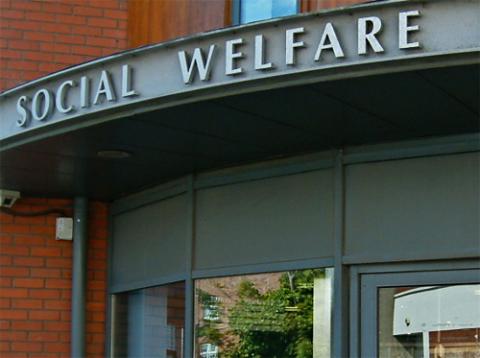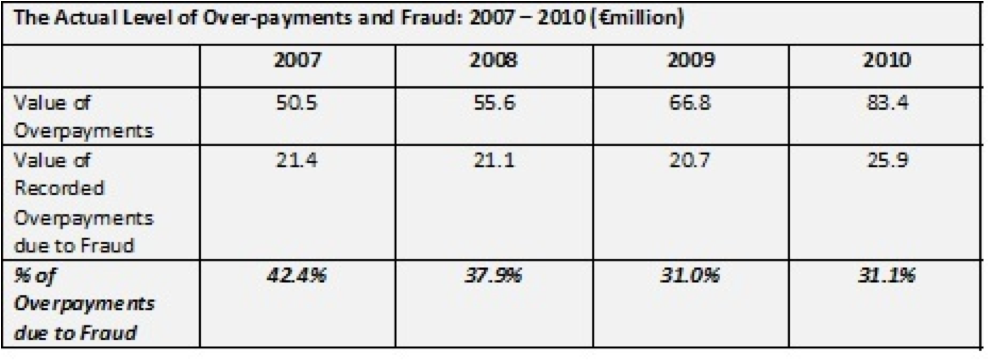The truth about social welfare fraud

"Tackling social welfare fraud" will not yield anything like €600 million in savings, since the real cost of fraud is something closer to €25 million. By Michael Taft.
“Minister of State Fergus O'Dowd has said that the Government believes it can save €600m by tackling social welfare fraud.”
The claim that the level of social welfare fraud is €600 million is, itself, a fraudulent claim. The level of social welfare fraud is €26 million. The level of fraud is not €600 million.
It suits a certain agenda which wants to soften up public opinion for social welfare cuts to claim that hundreds of millions are being lost to frauds and cheats. We have had television investigations, newspaper headlines, and attention-seeking politicians all claiming massive fraud. But out of a budget of nearly €20 billion, the Department of Social Protection has found only €25 million in fraudulent payments – or about 0.1% of the entire budget. So where did this famous "€600 million" in fraud come from? And why is the real level of fraud so much lower?
Control savings
First, the €600 million figure is not the actual amount of fraud in the social protection system. It is what is known as a “control saving”. According to the Deputy Secretary General and the Minister of the Department:
‘Control savings are not actual moneys recovered by the Department . . . ‘ (Deupty Secretary-General)
‘Control savings are not actual monies recovered by the Department . . ‘(Minister)
What are control savings?
“This figure is the value of the control activity in the Department and if this work did not take place there would, over time, be a similar increase in total social welfare expenditure.”
In other words, if there were no controls or inspections, there would be over time an estimated €600 million in overpayments. This is like the gardaí estimating the number of murders that might take place over time if there were no police force. Or the Revenue claiming the estimated level of tax fraud if there were no audits and checks. To my knowledge (and I’m open to correction on this) the Department of Social Protection is the only agency that uses this type of estimate publicly.
However, even this estimate is highly contrived and potentially flawed:
“Control savings are calculated by applying validated multipliers to the difference in the rate of payment before and after the control activity. Multipliers used in assessing control savings estimate the total future savings to the Department of a revocation or reduction resulting from a control action. The multiplier used is based on the average amount of time the person who ceases to claim will remain off the books before returning. This time varies from scheme to scheme.”
The important point is that the “control saving” is not an actual record of fraudulent payments. It is based on assumptions and multipliers. It is not based on one year – but can be spread out over two to three years.
And here, the Comptroller and Auditor General (C&AG) found a number of problems with the amounts claimed to have been “saved” in the control savings. For instance, an audit of Lone Parent cases found that nearly half of the cases claiming “savings” were actually mistaken. The C&AG also felt that overpayments estimates in pensions were themselves overestimates. The C&AG concluded:
“ . . . the Department’s current practice of including all of these overpayments arising from control activity as (bankable) savings is questionable.”
All this suggests that the €600 million – even as a control saving – is not a reliable figure.
Second, the €600 million control saving does not refer specifically to fraud. It refers to “overpayments”. Over-payments occur when (a) there is a mistake by the applicant/recipient, (b) there is a mistake by the administration, or (c) if there is a fraud. Fraud makes up only a minority of overpayments (see below).
In conclusion, when you hear the figure of €600 million fraud being used by a commentator or politician, remember: it does not refer to actual money the Department expects to find in any one year and only a minority of this highly contrived and, according to the C&AG, highly questionable figure has anything to do with fraud. To talk of €600 million in fraud is deeply fraudulent.
Actual fraud levels
So if the €600 million is not a reliable figure on fraud, what is? The C&AG’s report provides the figures, which is used by the Oireachtas Library & Research Service.

The actual annual level of overpayments is far below the €600 million figure. They rose from €50 million to €83 million between 2007 and 2010. But this included all overpayments – including mistakes by recipients and administration. The figures for fraud are substantially less:
- €21 million in 2007, rising to €26 million by 2010
- The percentage of overpayments due to fraud actually fell during this period – from 42% to 31%
What a contrast to the nonsense debate we have over the misunderstood, faulty and highly contrived figure of €600 million. The actual level of fraud that has been identified and recovered is €26 million.
Surveys and case reviews
The Department of Social Protection periodically conducts surveys of different social protection schemes to project the level of overpayments that might be in the system. The Department has surveyed eight schemes since 2004. The average level of overpayments in these surveys was 2.9%. The C&AG calculated that in 2010, this “potential” overpayment would be worth €383 million. However, we should note two things which suggest this figure is on the high side:
First, the number of case reviews yielding savings has fallen over the last few years. In 2008, the number of cases yielding savings was 19%. This fell to 9% in 2010. Therefore, surveys going back to 2004 should be treated cautiously.
Second, the C&AG has identified with the process of case reviews:
“However, in its present form, it is nonetheless a crude indicator, due to shortcomings in the savings calculation methodology and the fact that reviews of different type and intensity are aggregated.”
But it is important to remember that fraud makes up only 31% of actual over-payments. So even if we accepted the €383 million as a “potential” indicator, the fraud element of that potential is €119 million. The schemes not represented in these surveys – notably widow’s pensions, jobseekers’ benefit for example – are not likely to yield as much in overpayments as they are insurance schemes which don’t have the complexities as means-tested schemes that lead to high levels of mistakes and, so, overpayments.
Does the Government actually believe its own claims?
There is a doubt as to whether the Government actually believes its own claims. If I was Minister and believed there was serious dosh out there among the cheating community (more than the €26 million uncovered last year) I’d employ more inspectors. More inspectors mean more inspections, more cases covered and exposed. But there doesn’t appear to be much urgency on this matter. According to the Deputy Secretary General of the Department:
“There are over 400 social welfare inspectors, but not all of them are dedicated to fraud and control work. Since the level of unemployment increased, many of them have been involved in the processing of claims from new applicants . . . Over 200 staff are dedicated to carrying out control work. The special investigations unit operates at the high end has approximately 89 staff...We are not looking for additional inspectors as such...”
So 289 staff are involved. If another 100 inspectors could help double the level of fraud detection, they wouldn’t be costing the State money – they would be making the State money. So why aren’t the Department and the Government employing additional inspectors? Could it be they suspect that the gains wouldn’t be as high as the headline figure of €600 million suggests?
* * *
All this leads to a more mundane account of social protection fraud. Figures produced under “control savings” are constructed, spread out over years, and, according to the C&AG, “highly questionable”. Departmental surveys show a falling number of cases yielding savings which themselves are “crude”.
But we do have a concrete number - the actual level of detected fraud. And it is far, far lower than the numbers being thrown about in the public debate: €26 million, or 0.1% of the entire Social Protection budget.
Unfortunately, this is not a ‘sexy’ figure. It doesn’t make for screaming headlines and even louder commentators shouting for a crackdown on cheats and layabouts. It doesn’t make for an anti-welfare agenda.
All it does is make for a more accurate debate. That should be good enough. {jathumbnailoff}
Image top: Workers' Party of Ireland.
